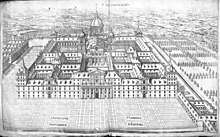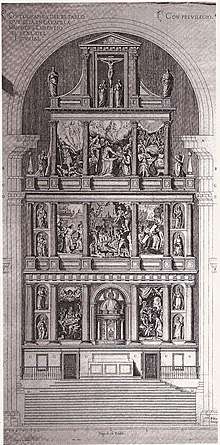Peter Perret
Peter Perret or Pieter Perret (Spanish: Pedro Perret)[1] (Antwerp, c. 1555 - Madrid, 1625), was a Flemish engraver who worked in Madrid in the service of Philip II of Spain.
Peter Perret | |
|---|---|
| Born | Pieter Perret 1555 |
| Died | 1625 |
| Other names | Spanish: Pedro Perret |
| Occupation | Engraver |
He married Isabel de Faria, who was born in Portugal, with whom he had a son, also named Peter. His son, also an engraver, Spanishized his name and went by "Pedro Perete."[2]:165
Background

Born in Antwerp around 1555, he was a pupil of engravers Maarten de Vos and Gerard de Jode.[3]:39-68. Prior to 1578 he studied engraving in Rome with Cornelis Cort. After that, he returned to Antwerp, eventually moving to Bavaria, where he was appointed engraver of the William IV, Duke of Bavaria and the Elector of Cologne.[4] During this time, he may also have worked in Paris for publisher Nicolas Le Bon.[5]:160
In 1584 Juan de Herrera, commissioned Perret to print images the plants and topographical views of the Monastery of San Lorenzo Del Escorial.[5]:160 Herrera was to provide the copper plates already drawn by his hand, and Perret was to engrave them for a fee of 600 ducats. Perret moved to Madrid and was bound to take on no other work until the plates were engraved.[6]:142-143 However, the work was not completed until 1589. That year, they were collected in a small book entitled, Sumaria y breve declaración de los diseños y estampas de la fábrica de San Lorenzo del Escorial and sold by Herrera. Despite the prohibition on taking on other work, Perret published the first of his portraits, that of the Empress Maria of Austria in 1585.[2]:122

In 1590 he returned to Antwerp where be became a master in the Guild of Saint Luke in 1594.[7]:377 Between 1591 and 1595, he published some allegorical engravings based on drawings provided by Otto van Veen, among them were works dedicated to Herrera and Philip II.[2]:124 Other works from this time are three small plates of prophets (Daniel, Ezekiel and Haggai) according to designs by Nicolas van Houy for the work Icones prophetarum maiorum et minorum (1594) published in Antwerp by Philip Galle. Copies of these three prophets are preserved in the Lázaro Galdiano Museum in Madrid.[2]:124
In 1595 he was appointed as a court engraver by Philip II, with a salary of 100 ducats per year. With the royal appointment, he established himself in Madrid, focusing on the book publishing. He focused not only book covers and portraits, but also typographic marks and small ornaments.[2]:124 Perret published at least thirty-four books while in Madrid, with more in Lisbon, where he may have moved during the Iberian Union.[5]:160
Some of his best known works of this time are portraits, including the Retrato de San Ignacio de Loyola (English: Portrait of Saint Ignatius of Loyola) included in the Obras of Father Ribadeneira. Also notable are the portraits of the Cistercian theologian Jerónimo Llamas , that of Mateo Alemán, published with the first part of Guzmán de Alfarache, and that of Ginés Rocamora, collected in his Sphera del Universo,[2]:125 which also included a strongly mannerist-looking allegory of Astronomía, copied from Johan Sadeler. [8]:97
Between 1609 the time of his death, he published the covers of most of the books in Madrid.[2]:126 Among the books published are La conquista de las Molucas (English: The Conquest of the Moluccas), by Bartolomé Leonardo de Argensola in 1609, De la veneración que se debe a los cuerpos de los santos y a sus reliquias (English: On the veneration due to the bodies of the saints and their relics), by Sancho Dávila Toledo, Bishop of Jaén in 1611; Compendio de las fiestas que se hicieron en la beatificación de la madre Teresa de Jesús (English: Compendium of the festivities that took place in the beatification of Mother Teresa de Jesús), by Diego de San José in 1615; Council and counselor of princes, by Lorenzo Ramírez de Prado in 1617; Filipe Segundo Rey de España, by Luis Cabrera de Córdoba in 1619, with an image of Phillip II as "defender of faith,"[9]:129 He provided two interior illustrations on designs by the architect Juan Gómez de Mora. His also seems to be the cover of the Eróticas or Amatorias, by Esteban Manuel de Villegas, printed in Nájera in 1618 by Juan de Mongastón.
Further reading
- Santiago Páez, Elena; otros (1985). El Escorial en la Biblioteca Nacional (in Spanish). Madrid. ISBN 84-505-2529-2.
- Zarco del Valle-Conde las Navas (Espinosa Quesada), "Pedro Perret (1555-1639)". Homenaje a Menéndez Pelayo (in Spanish). I. Madrid. 1899. pp. 582–587.
- Diccionario historico de los mas ilustres porfesores de las bellas artes en España. Reales Academias de bellas artes de San Fernando y de la historia. Madrid. 1965.
References
- "Pieter Perret". Netherlands Institute for Art History.
- Gallego, Antonio (1999). Historia del grabado en España (in Spanish). Madrid: Ediciones Cátedra. ISBN 84-376-0209-2.
- Hollstein, F.W.H. (1948). Dutch and Flemish Etchings, Engravings and Woodcuts ca. 1450-1700. 17. Amsterdam: Menno Hertzberger.
- Ceán Bermúdez, Juan Agustín (1800). Diccionario histórico de los más ilustres profesores de la Bellas Artes en España (in Spanish). IV. Madrid. pp. 87–93.
- Allgemeines Künstlerlexikon : die bildenden Künstler aller Zeiten und Völker (in German). 95. K.G. Saur. 1948. ISBN 978-3598227967.
- Saltillo, M. (1953). Un informe de Juan Gómez de Mora sobre Pedro Perret. Boletín de la Sociedad Española de Excursiones (in Spanish). pp. 142–143.
- Rombouts, P. De Liggeren en andere historische archieven der Antwerpsche Sint Lucasgilde = Les Liggeren et autres archives historiques de la Gilde Anversoise de Saint Luc. 1. Antwerp: Baggerman.
- López Torrijos, Rosa (1985). Los años de El Escorial: imágenes históricas y simbólicas. Santiago Páez y otros (in Spanish). p. 97.
- Los Austrias. Grabados de la Biblioteca Nacional, catálogo de la exposición (in Spanish). Madrid. 1993. ISBN 84-7896-043-0.
External links
| Wikimedia Commons has media related to Pedro Perret. |